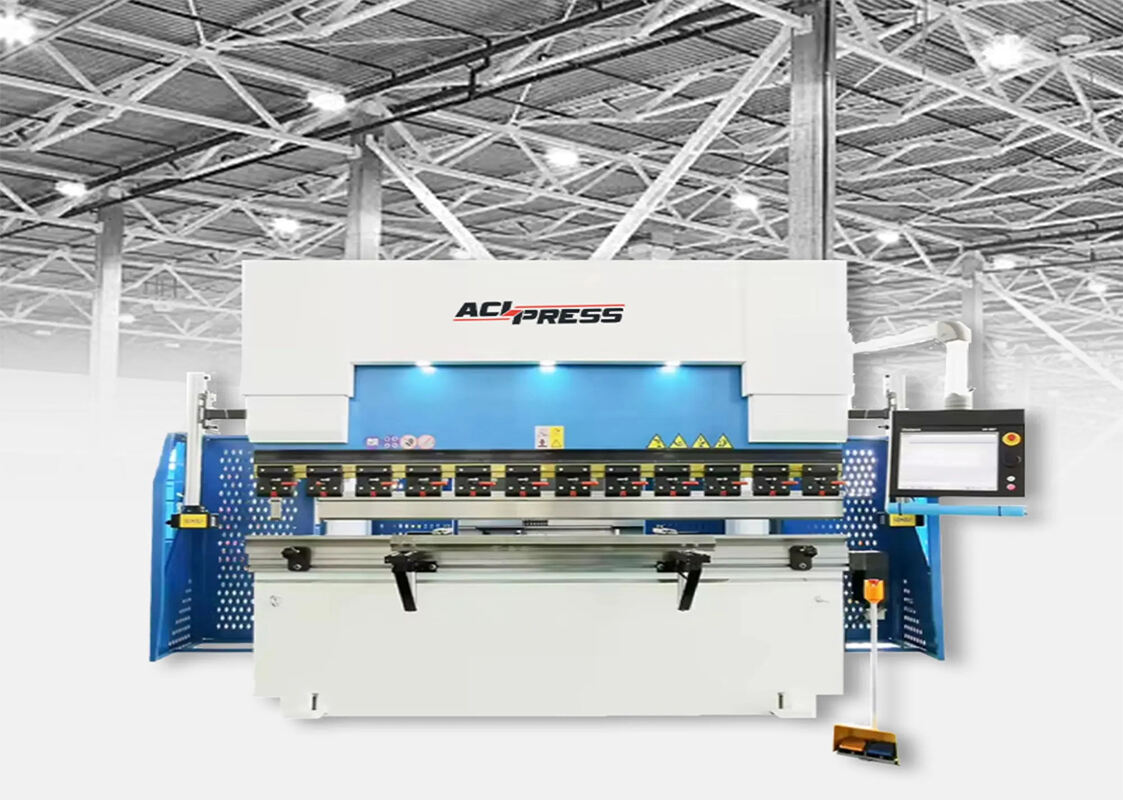Hoe torsieas drukvouwmachines en elektro-hydraulische CNC drukvouwmachines te herkennen en te kiezen
In de metaalbewerkingsindustrie speelt de pressbrake machine (bouwmachine) een cruciale rol bij het vormgeven van plaatmetaal tot verschillende gewenste vormen. Door technologische vooruitgangen zijn bouwmachines geëvolueerd, wat heeft geleid tot twee veelgebruikte typen: torsiebouwmachines en elektro-hydraulische bouwmachines. Aclpress wil hier de belangrijkste verschillen tussen hen uitleggen.
1. Werking:
De draaiende as buigmachine gebruikt mechanische krachttransmissie om de positie van de onderste vormhand matig handmatig aan te passen, waardoor plaatbuigen wordt voltooid. Normaal gesproken wordt een hand-buigmachine gebruikt, waarbij kracht wordt overgedragen naar de onderste vorm via een handvat of voetpedaalbesturingssysteem, wat het buigen van platen mogelijk maakt. Een elektro-hydraulische CNC buigmachine werkt met een elektro-hydraulisch servosysteem, dat een hydraulische cilinder of een elektro-hydraulisch servosysteem activeert om de onderste vorm te verplaatsen. Het CNC-systeem controleert nauwkeurig de positie en snelheid van de vorm om precieze buighoeken en -vormen te bereiken.
2. Nauwkeurigheid en belastingscapaciteit:
De parallelisme van de schuif is een cruciale factor die invloed heeft op de hoek van het werkstuk. Het mechanisch gedwongen synchronisatiemodus dat wordt gebruikt in draaikraakmachines ontbreekt echter aan real-time foutfeedback, wat resulteert in een lagere machineringnauwkeurigheid. Bovendien heeft de buigmachine beperkte belastingscapaciteit en kan langdurige bedrijfsvoering onder excentrische belastingen leiden tot verforming van de draaispil. Om precisie-machinering te bereiken, maakt de elektro-hydraulische CNC-buigmachine gebruik van een gesloten lus besturingssysteem dat bestaat uit een CNC-systeem, een hydraulische controlegroep en een optische rasterliniaal voor feedback. Daarnaast opereren de Y1- en Y2-as onafhankelijk van elkaar, wat uitstekende buikwaliteit garandeert, zelfs onder onevenwichtige belastingen.
3. Verschillende bedieningsmethoden:
De draaikrachtschuinmachine heeft doorgaans geen besturingssysteem en V-as compensatiefunctie, waardoor de bediening relatief zwaar is. Operateurs moeten zwaar leunen op hun ervaring en vaardigheden om buigtests uit te voeren en aanpassingen te maken tijdens het verwerkingsproces, wat niet alleen tot potentiële verspilling kan leiden, maar ook hoge vaardigheidsniveaus van werknemers vereist. In tegenstelling daarmee is de elektro-hydraulische CNC buigmachine uitgerust met een professioneel CNC-systeem dat eenvoudige bediening mogelijk maakt en een hoog niveau van intelligentie biedt. Door het tekeningen in het CNC-systeem in te voeren, kunnen operateurs de buigproces automatisch uitvoeren. Bovendien bevat de elektro-hydraulische CNC buigmachine een simulatiebuigfunctie voor pre-verwerkingsimulaties om nauwkeurigheid en stabiliteit te garanderen.
4. toepassingen:
De torsiebuigmachine is geschikt voor eenvoudige plaatbuiging en voldoet aan de lagere eisen van buigproducten qua materiaal en formaat.
De elektro-hydraulische CNC buigmachine is ideaal voor het buigen van complexere vormen van platen, waarbij de eisen aan hogere nauwkeurigheid in buigbewerkingen worden voldaan. Deze machine kan ook grotere en verschillende soorten materialen verwerken.
Het geheel betreft uitsluitend typische verschillen, en de elektro-hydraulische CNC buigmachine heeft geleidelijk de torsieas-buigmachine vervangen vanwege zijn voordelen, uitstekende precisie, hoge belastingscapaciteit voor flexie, eenvoudige en snelle werkwijze, evenals opmerkelijke verwerkings-efficiëntie.
Bij het kiezen van buigapparatuur is het echter raadzaam om rekening te houden met de daadwerkelijke vraag en budget, alsook de specifieke kenmerken van ontworpen machines.

Aanbevolen producten
Hot News
-
Een Gids voor het Verwijderen van Lasranden en -schuursel
2024-05-16
-
Prestaties van de CNC drukvouwmachine
2024-05-24
-
Hoe torsieas drukvouwmachines en elektro-hydraulische CNC drukvouwmachines te herkennen en te kiezen
2024-06-20
-
Meester in metaalvouwen: de onmisbare drukvouwmachine
2025-02-08
-
Tips voor onderhoud van schaarmachines om de levensduur van apparatuur te verlengen
2025-02-08

 EN
EN
 AR
AR
 NL
NL
 FR
FR
 DE
DE
 IT
IT
 JA
JA
 KO
KO
 PT
PT
 RU
RU
 ES
ES
 TL
TL
 ID
ID
 VI
VI
 TR
TR











